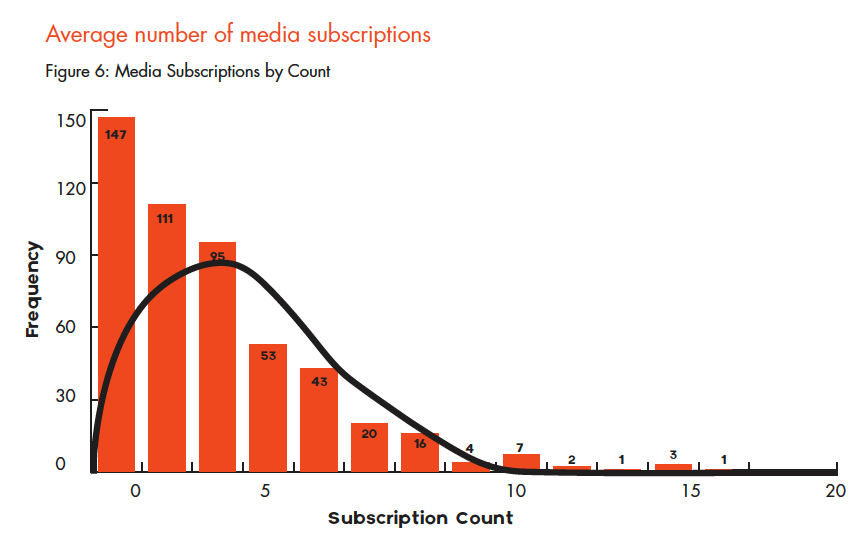|
Getting your Trinity Audio player ready...
|
The subscription economy has grown more than 300 percent since 2012, but it is tech giants such as Netflix and Spotify that have mainly benefited from this. Even among the growth in news media subscriptions, national titles have dominated: The New York Times and The Washington Post account for more than half of all US online news subscriptions. Furthermore, recent research from Reuters found that even among people who are willing to pay for online news, most are only willing to pay for one subscription. With all this in mind, local and regional publishers have started to worry readers will reach subscription fatigue before they are willing to pay for local news.
That’s why News Media Alliance and the University of Minnesota Hubbard School of Journalism and Mass Communication teamed up with the Star Tribune in Minnesota to study how a regional publisher is able to successfully grow digital subscribers. The whole report is well worth a read and can be downloaded by NMA members here; we’ve highlighted a few of the key learnings below.
Subscribers are willing to pay
An interesting finding in the report was that readers are actually more willing to pay for media subscriptions than they think: consumers reported being willing to spend $600 per year (approximately 545€), while in reality they paid closer to $700 per year (approximately 636€). In 2020, this number is expected to grow even more, nearly doubling to $1200 per household each year (approximately 1090€), according to research from Deloitte. While this growth may be driven by subscriptions to Netflix and Spotify, that does not necessarily mean it comes at the expense of publishers. This study found a clear connection between consumer spending on Netflix and online news media subscriptions. Previous research found this to be true at a country level as well: the more people in a country that pay for Netflix or Spotify, the more people also pay for online news.
Additionally, it is not necessarily a competition between national and local publishers. This study found that local news subscriptions can be a driver for national news subscriptions, as well as additional local news subscriptions. There was also an interesting finding regarding education and the willingness to pay: more educated consumers were less willing to pay for an online news subscription. The researchers posit that perhaps the higher educated consumers are more discerning or selective about their subscription choices.

The study also looked at how many media subscriptions the consumers actually had. On average, households had almost four paid subscriptions. This favored entertainment subscriptions a bit more, with 2.5 falling in that category and 1.3 in the news category. Still, it shows that consumers are willing to pay for multiple subscriptions and have not yet reached ‘subscription fatigue’.
Build the right relationship with your readers
To reach these potential subscribers, newspapers will need to provide their readers with what they find valuable. That’s one reason why media consultant Ken Doctor has been asking media executives for the past decade: “what percentage of your visitors drive 50% of your site’s traffic?” These super engaged readers are the ones most likely to actually pay for your content. On average, it is just 7% of monthly unique visitors that drive 50% of traffic.
Only through knowing our audiences in this way will we be able to offer products they value enough to subscribe.
Steve Yaeger, Chief Marketing Officer at the Star Tribune
Ken Doctor has highlighted the Star Tribune in the past as well for performing above what its regional geography would otherwise suggest. While Minneapolis is only the 16th largest metro market in the country, the Star Tribune is ranked 5th in circulation. This is in part because they have been able to convert 1% of their more than 5 million monthly unique visitors. Local publishers can benefit from reviewing their conversion strategy and making small tweaks as possible. For example, more publishers are experimenting with registration walls, which ask readers to give their email to access content before asking them to pay. This is beneficial because the reader becomes a known quantity, and you are better able to encourage them to subscribe. One publisher Ken Doctor studied had a large group of super-engaged readers, 20% of their total audience, but only 1.3% of those readers had provided their email address. Without this information, publishers aren’t able to personalise their digital subscription offers to trigger more conversions. Just as you wouldn’t ask someone to marry you on the first date, it is important to build up the relationship with your readers before asking them to subscribe.
It is also important to understand what motivates your readers specifically to subscribe. For the Star Tribune, they saw their sports readers were more willing to pay for a subscription than non-sports readers. This is consistent with research we recently did exploring the rise of sports-only subscription vertical products, such as McClatchy’s ‘SportsPass’.
There’s hope for local
To compete against national players, it is key to provide the content they cannot: local stories told by local reporters. But this doesn’t mean only local stories matter; there’s still a strong demand for national news in smaller markets. Readers need both the local stories they can’t get anywhere else, along with the national stories that help provide insights and context for the wider world. Publishers are starting to act on this, switching away from “commodity news” to truly local news.
The evidence that audiences are unwilling to pay for local news is actually clouded by the fact that most local news is not local at all.
Rachel Davis Mersey, assistant professor at the Medill School
We have seen this be quite successful for Mittmedia, Sweden’s leading local media company. After the team found that many new subscribers had read a local story before deciding to subscribe, they decided to amp up their local coverage. One topic that worked especially well was stories on new houses that had been built or recently sold. So they built a bot that writes a short text on every house that is sold in their local markets, identifying an interesting angle (such as the most expensive house sold in the year) and adding an image from Google Streetview. This is a fully automated process, as the names of buyers are a matter of public record in Sweden. Not only has this bot created content generating several hundred new paying subscribers, it is also the most consumed content by existing subscribers.
Hyper local news also works especially well in Germany, where we can see a still strong local market for news. Recently SüdKurier decided to revamp their entire digital strategy to ensure they were best meeting the needs of their local communities. They mapped out how often they were covering each community with valuable content against its population. The team was surprised with the results, some small towns were way over-represented while larger communities, with a larger potential subscriber base, were not covered nearly often enough.
There’s plenty of room to rethink how we share local news today. For example, our own team is currently working with a French publisher to automatically republish relevant local stories from the archives, as part of the Google News Initiative fund. Recently we just saw US publishers also receive funding from Google to focus on hyperlocal, so we look forward to seeing how local news progresses in 2020.
Mary-Katharine Phillips
Media innovation analyst @ Twipe


